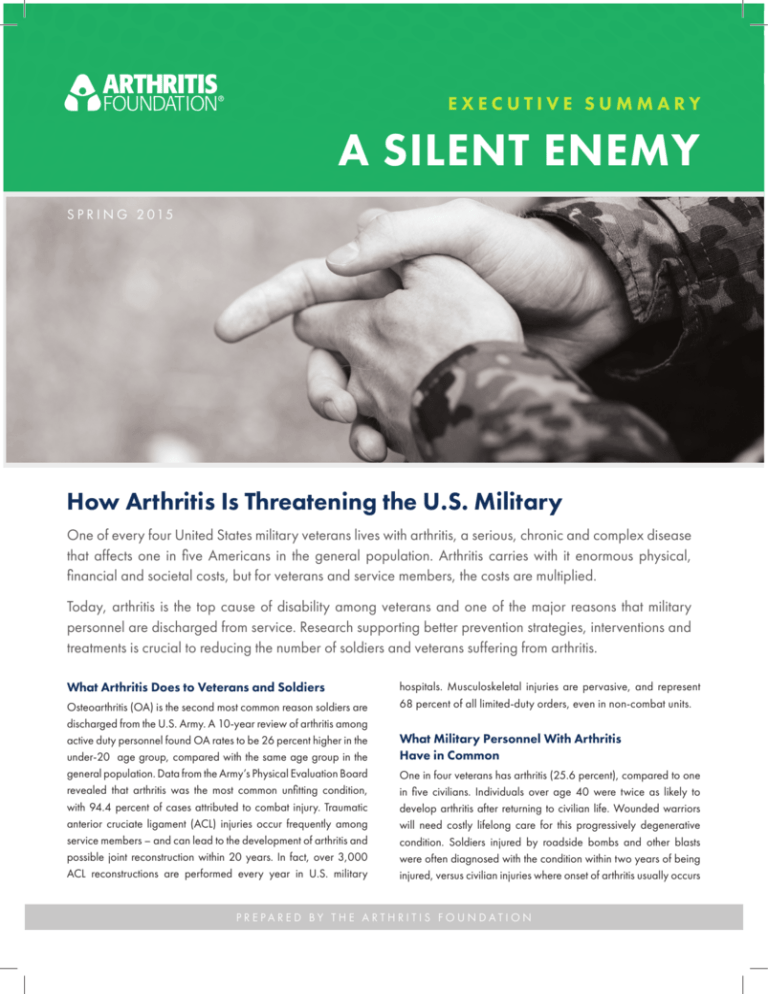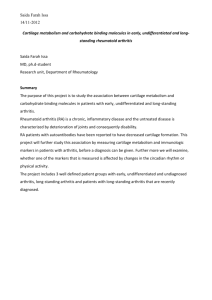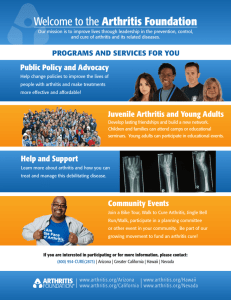executive summary - Arthritis Foundation
advertisement

EXECUTIVE SUMMARY A SILENT ENEMY S P R I N G 2 015 How Arthritis Is Threatening the U.S. Military One of every four United States military veterans lives with arthritis, a serious, chronic and complex disease that affects one in five Americans in the general population. Arthritis carries with it enormous physical, financial and societal costs, but for veterans and service members, the costs are multiplied. Today, arthritis is the top cause of disability among veterans and one of the major reasons that military personnel are discharged from service. Research supporting better prevention strategies, interventions and treatments is crucial to reducing the number of soldiers and veterans suffering from arthritis. What Arthritis Does to Veterans and Soldiers Osteoarthritis (OA) is the second most common reason soldiers are discharged from the U.S. Army. A 10-year review of arthritis among active duty personnel found OA rates to be 26 percent higher in the under-20 age group, compared with the same age group in the general population. Data from the Army’s Physical Evaluation Board revealed that arthritis was the most common unfitting condition, with 94.4 percent of cases attributed to combat injury. Traumatic anterior cruciate ligament (ACL) injuries occur frequently among service members – and can lead to the development of arthritis and possible joint reconstruction within 20 years. In fact, over 3,000 ACL reconstructions are performed every year in U.S. military hospitals. Musculoskeletal injuries are pervasive, and represent 68 percent of all limited-duty orders, even in non-combat units. What Military Personnel With Arthritis Have in Common One in four veterans has arthritis (25.6 percent), compared to one in five civilians. Individuals over age 40 were twice as likely to develop arthritis after returning to civilian life. Wounded warriors will need costly lifelong care for this progressively degenerative condition. Soldiers injured by roadside bombs and other blasts were often diagnosed with the condition within two years of being injured, versus civilian injuries where onset of arthritis usually occurs P R E PA R E D BY T H E A R T H R I T I S F O U N D AT I O N EXECUTIVE SUMMARY 10 years later. Arthritis complicates chronic disease management among veterans. More than half of veterans with heart disease or diabetes also have arthritis. Rheumatoid arthritis (RA) is known to advance the progression of cardiovascular disease; data from the Veterans Affairs Rheumatoid Arthritis registry confirms that the mortality rate among veterans with RA is considerably more than double the rate among those without RA. Why Soldiers Are More Prone to Arthritis Even in basic training, soldiers are carrying 60-100+ lb. packs that can injure and weaken their joints, which can lead to arthritis. Combat injuries increase the risk for arthritis: For example, shock waves from bomb blasts can cause early joint damage, which in turn may lead to early onset arthritis. Post-traumatic osteoarthritis can be severely disabling and debilitating. Soldiers are often injured at a young age, which translates to more years of jointrelated symptoms, activity limitations and risks associated with medical procedures. How Further Arthritis Research Can Help Research can help identify ways to lessen joint injury during military training; it’s important to study people after a joint injury rather than just looking at people who have already been diagnosed with osteoarthritis. Research on the genetics and epigenetics of rheumatoid arthritis can help us better understand what causes RA, which can lead to more effective treatments with fewer side effects. Why Department of Defense (DoD)-Funded Arthritis Research Is Key There is a growing burden of arthritis among active duty military and veteran populations. Arthritis negatively affects the ability of active duty members to perform their duties, and it limits the quality of life for veterans. Arthritis is responsible for rising DoD and VA health care costs because of its impact on disease management, joint pain, loss of function and joint replacement surgery. Currently, arthritis and clinical care research – on both active duty military and veteran populations – is very limited. Arthritis research has been funded at the DoD since Fiscal Year 2010 in the Peer Reviewed Medical Research Program (PRMRP) within the Congressionally Directed Medical Research Program (CDMRP). Since that time, the number of topics authorized by Congress has increased from one to four, and now includes OA, post-traumatic OA, RA and arthritis overall. To date, a total of 14 grants have been funded. However, arthritis topics compete against the other 37 medical topics authorized in the PRMRP, so funding is not guaranteed. Recommendation Congress should authorize the creation of a stand-alone arthritis program within the DoD’s Congressionally Directed Medical Research Program – funded at $20 million – to ensure more dedicated research funding to meet the growing needs of active military personnel and veterans. Arthritis research that helps our military and veteran populations will benefit everyone with arthritis, a debilitating disease that attacks one in five Americans in the general population. Learn more at arthritis.org/advocate P R E PA R E D BY T H E A R T H R I T I S F O U N D AT I O N









